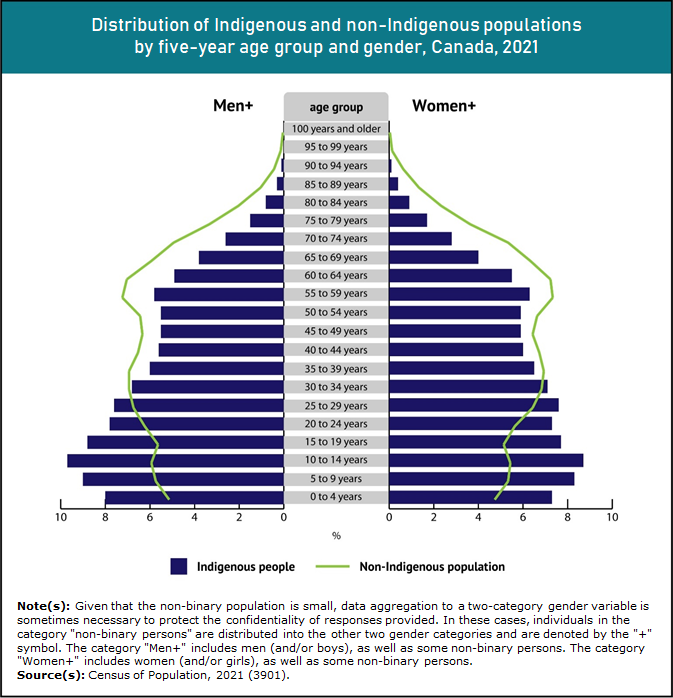Infographic 3
While Indigenous people remain younger than non-Indigenous population, young Indigenous children (0 to 4 years) account for smaller share of population than in the past

Infographic description
The title of the infographic is "While Indigenous people remain younger than non-Indigenous population, young Indigenous children (0 to 4 years) account for smaller share of population than in the past"
This infographic comprises two overlapping pyramids that represent the age and gender structure of the Indigenous population (indicated by solid horizontal bars) and the non-Indigenous population (indicated by an outline) in 2021.
The line and horizontal bars on the y-axis are located in the middle of the chart and divide the pyramids in two. They indicate the five-year age groups starting from 0 to 4 years, up to 100 years and older. People in the "Men+" category are represented on the left side of the axis, and people in the "Women+" category on the right side.
The horizontal bars on the x-axis represent the percent distribution of the Indigenous population and non-Indigenous population for each age group, from 0.0 to 10.0 in intervals of 2.0. They are identical on both the right and left sides of the y-axis.
For the Indigenous population in the "Men+" category, those aged 0 to 4 years made up 8.0% of the population; 5 to 9 years, 9.0%; 10 to 14 years, 9.7%; 15 to 19 years, 8.8%; 20 to 24 years, 7.8%; 25 to 29 years, 7.6%; 30 to 34 years, 6.8%; 35 to 39 years, 6.0%; 40 to 44 years, 5.6%; 45 to 49 years, 5.5%; 50 to 54 years, 5.5%; 55 to 59 years, 5.8%; 60 to 64 years, 4.9%; 65 to 69 years, 3.8%; 70 to 74 years, 2.6%; 75 to 79 years, 1.5%; 80 to 84 years, 0.8%; 85 to 89 years, 0.3%; 90 to 94 years, 0.1%; 95 to 99 years, 0.0%; and 100 years and older, 0.0%.
For the Indigenous population in the "Women+" category, those aged 0 to 4 years made up 7.3% of the population; 5 to 9 years, 8.3%; 10 to 14 years, 8.7%; 15 to 19 years, 7.7%; 20 to 24 years, 7.3%; 25 to 29 years, 7.6%; 30 to 34 years, 7.1%; 35 to 39 years, 6.5%; 40 to 44 years, 6.0%; 45 to 49 years, 5.9%; 50 to 54 years, 5.9%; 55 to 59 years, 6.3%; 60 to 64 years, 5.5%; 65 to 69 years, 4.0%; 70 to 74 years, 2.8%; 75 to 79 years, 1.7%; 80 to 84 years, 0.9%; 85 to 89 years, 0.4%; 90 to 94 years, 0.1%; 95 to 99 years, 0.0%; and 100 years and older, 0.0%.
For the non-Indigenous population in the "Men+" category, those aged 0 to 4 years made up 5.1% of the population; 5 to 9 years, 5.7%; 10 to 14 years, 5.9%; 15 to 19 years, 5.6%; 20 to 24 years, 6.2%; 25 to 29 years, 6.7%; 30 to 34 years, 6.9%; 35 to 39 years, 6.9%; 40 to 44 years, 6.5%; 45 to 49 years, 6.3%; 50 to 54 years, 6.4%; 55 to 59 years, 7.2%; 60 to 64 years, 7.0%; 65 to 69 years, 5.9%; 70 to 74 years, 4.9%; 75 to 79 years, 3.3%; 80 to 84 years, 2.0%; 85 to 89 years, 1.0%; 90 to 94 years, 0.4%; 95 to 99 years, 0.1%; and 100 years and older, 0.0%.
For the non-Indigenous population in the "Women+" category, those aged 0 to 4 years made up 4.7% of the population; 5 to 9 years, 5.3%; 10 to 14 years, 5.4%; 15 to 19 years, 5.1%; 20 to 24 years, 5.6%; 25 to 29 years, 6.4%; 30 to 34 years, 6.8%; 35 to 39 years, 6.9%; 40 to 44 years, 6.7%; 45 to 49 years, 6.4%; 50 to 54 years, 6.6%; 55 to 59 years, 7.3%; 60 to 64 years, 7.2%; 65 to 69 years, 6.3%; 70 to 74 years, 5.3%; 75 to 79 years, 3.6%; 80 to 84 years, 2.3%; 85 to 89 years, 1.3%; 90 to 94 years, 0.6%; 95 to 99 years, 0.1%; and 100 years and older, 0.0%.
The age pyramid for the Indigenous population has a wide base and a narrow apex, giving it a pyramid shape. For the Indigenous population, the widest area of the age pyramid is for those aged 5 to 19 years. The shape of the age pyramid for the non-Indigenous population is less like a pyramid and more like a mushroom, with a narrower base, a wider area at ages 55 to 64 years and a pointed apex.
Note(s): Given that the non-binary population is small, data aggregation to a two-category gender variable is sometimes necessary to protect the confidentiality of responses provided. In these cases, individuals in the category "non-binary persons" are distributed into the other two gender categories and are denoted by the "+" symbol. The category "Men+" includes men (and/or boys), as well as some non-binary persons. The category "Women+" includes women (and/or girls), as well as some non-binary persons.
Source(s): Census of Population, 2021 (3901).
- Date modified: